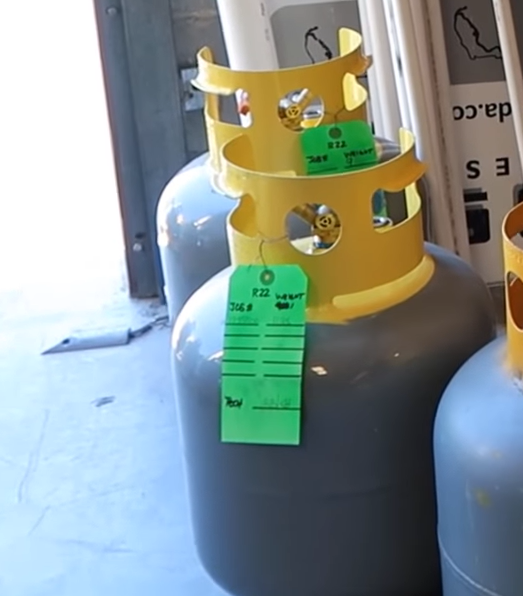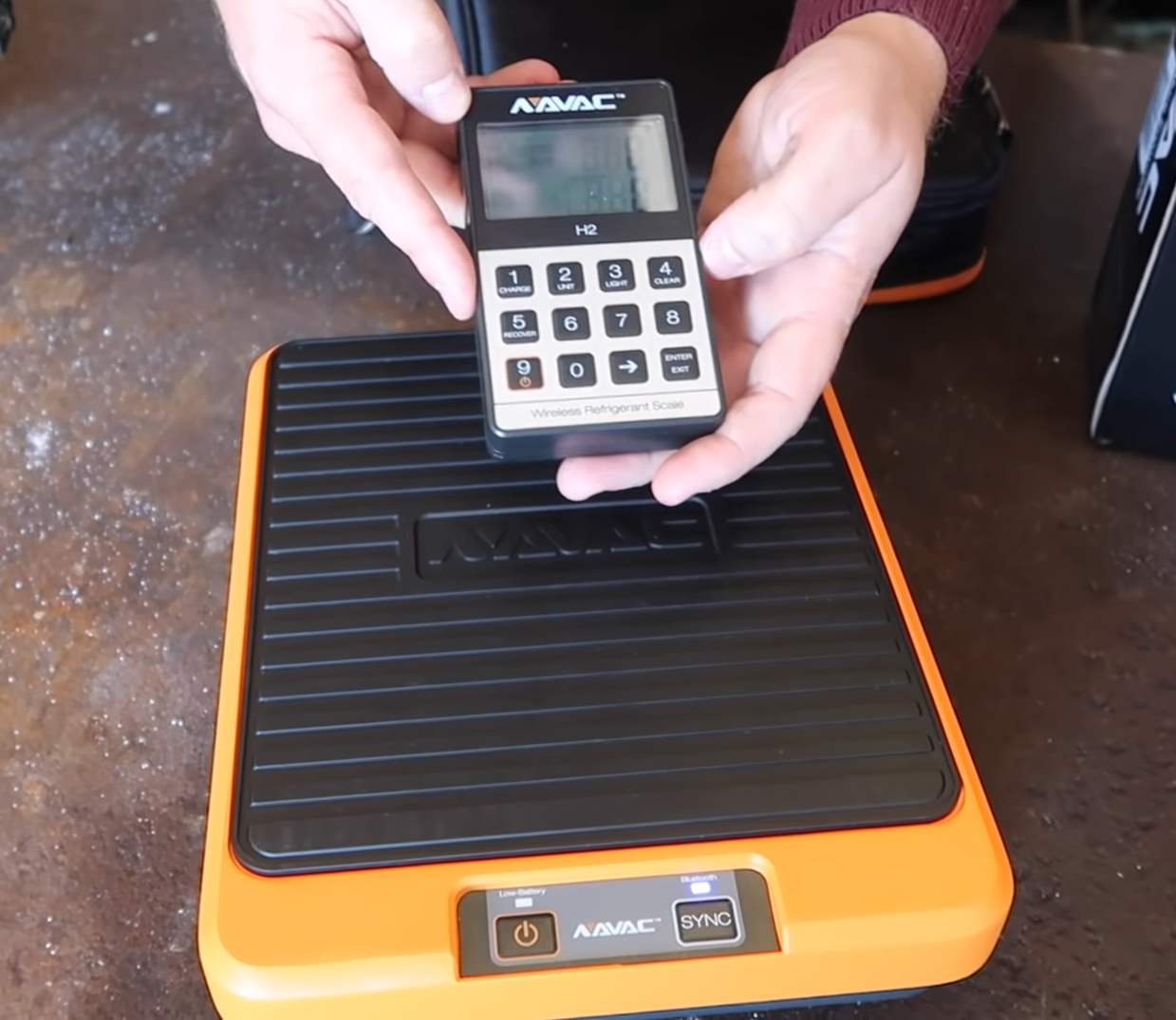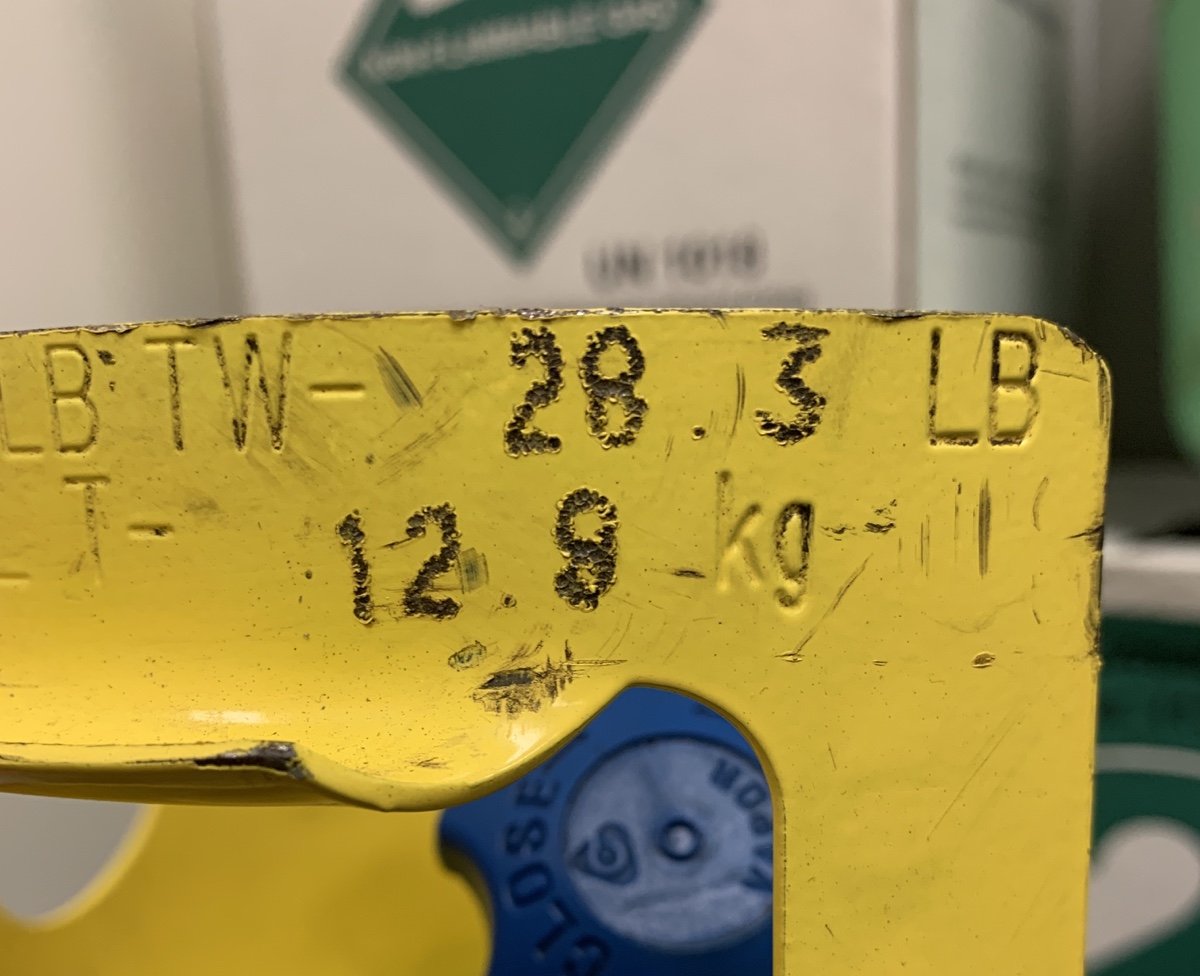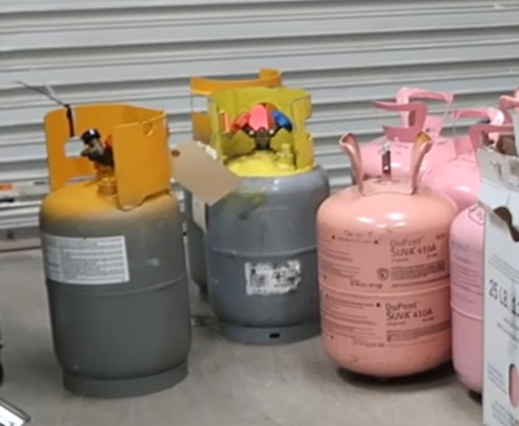Get Tech Tips
Subscribe to free tech tips.
Recovery Tank Safety
DISCLAIMER: HVAC School is NOT an official OSHA safety training resource! Although we provide safety tips in good faith, our website is not a substitute for safety training from an authorized OSHA training source.
We have already touched on safety in previous tech tip features about recovery tanks, as recovering refrigerant can be a surprisingly dangerous job. We feel that the subject of recovery cylinder safety warrants its own article and discussion.
Recovery is also more critical than ever at this time. We are officially in the R-22 phaseout period, and we want technicians to be safe for their sake and their customers’.
This article will touch on tank condition, hydrostatic pressure buildup, and proper procedures for handling and transporting refrigerant tanks.
Use your senses to inspect the tank thoroughly

It seems like we use some variation of the phrase “use your senses” in every fourth tech tip or so. Well, we’re saying it again today with good reason. Your senses could quite literally save your life if you use them to inspect a cylinder before you fill it.
Before you even think about putting a tank on your truck to go to a job site, thoroughly inspect the tank. Start with a basic physical inspection. The main things you’ll want to look for are dents, punctures, and rust. If you see any signs of damage or corrosion, discontinue the use of that tank. (Of course, you’ll also want to make sure that your recovery tank is gray with a yellow top! The tank colors exist for a reason, and you don’t want to use them all interchangeably.)
Then, you’ll want to inspect the valves. That’s a process that requires somewhat sharper perception skills than the previous type of inspection, but you’ll mostly want to look for leaky valves and signs of damage or tampering. Again, if a tank’s valves appear to be damaged, leaky, or suspicious-looking, it will be best to discontinue the use of that tank.
It’s also a best practice to ensure that each technician tags every tank they use with their name, the date filled, and the refrigerant recovered. This practice helps prevent refrigerant mixing, which is bad for the environment and even worse for your safety. Different refrigerants have different temperature-pressure relationships. These relationships help you figure out the proper maximum tank fill level for safety, so they're kind of a big deal. Mixing refrigerants in a tank will make it difficult to determine safe fill levels at the temperatures you’ll experience. If the company you work for already does this practice, make sure you read those tags or labels.
Know what those stamped numbers mean

You may have noticed that recovery tanks have three numbers stamped on them, typically on the rim or near the tank’s top. You will see TW, WC, and DOT on the tank, and each one is critical to your safety.
TW stands for tare weight, and it represents the weight of the empty tank. This value is important because you must subtract this number from a scale reading to figure out how much refrigerant you put in the tank. Your scale could read 36.8, but 17 of those pounds could be attributed to the tank weight. There’s a pretty big difference between 36.8 and 19.8 pounds of refrigerant, so make sure you’re always accounting for the tare weight when using a scale.
WC stands for water capacity, representing the amount of water required to fill the tank to 100% capacity. However, we do NOT use water as a refrigerant, and we should NEVER fill our tanks to 100% capacity. So, what purpose does this value serve? We’ll cover that in detail later, but water is simply a good comparison that we can use to convert the refrigerants’ specific gravities.
The DOT rating looks different. One common rating you’ll see is “DOT-4BA400.” The DOT stands for the U.S. Department of Transportation, which enforces tank manufacturing and testing protocols. The 400 represents 400 PSI, which is the tank’s rated pressure. Tanks are always tested to withstand double those pressure conditions (in this case, 800 PSI), but it’s a foolish idea to push your luck. The DOT value lets you know how much pressure your tank can withstand before something catastrophic happens (explosions). Needless to say, it would be in your best interest to be mindful of these values.
A scale is your best friend

I know what you might be thinking; scales can hurt our feelings. The scale in my bathroom has hurt my feelings more than a few times, so I wouldn’t exactly call that scale a friend of mine.
All joking aside, keeping a scale on your truck will help you stay safe during the recovery process. Make sure you bring it out every single time you’ll be recovering or charging refrigerant. Weigh the charge each time, even if you feel confident that you can recover all the refrigerant and stay within a safe capacity range.
Recovery is not a good task for playing the guessing game; it could quickly turn into Russian roulette. A scale will allow you to keep track of what you put into a cylinder and take out of it.
The best practice is to use the scale during recovery, too. When you do that, you can observe the weight increase as the refrigerant goes into the tank. If you want the refrigerant to enter the tank as a liquid when there’s no dip tube, invert the tank on the scale.
Figure out your maximum capacity, and DO NOT exceed it!

We already touched on capacity when we talked about WC (water capacity). We said two main things: (1) we don’t use water as a refrigerant, and (2) we NEVER fill cylinders to 100% capacity.
Water is a poor refrigerant because it has a high boiling point, making it ineffective in the refrigeration cycle. Therefore, we use refrigerants with low boiling points. However, water is a stable, abundant compound that’s easy to measure, so it’s an excellent standard medium for comparisons. One crucial comparison is the measure of specific gravity, which divides a substance’s density by the density of water.
The refrigerants we use have different densities than water. We can use the specific gravity ratio to determine our capacity using the WC value given. To determine the capacity in terms of a given refrigerant instead of water, you would multiply the specific gravity of a refrigerant at the maximum temperature you’ll be exposed to (SG) by WC and add it to the tare weight (TW) to get the total tank weight. It should fit into an equation like this:
SG x WC + TW
HOWEVER, that would tell us 100% capacity. Filling the tanks to 100% capacity could be a potentially fatal error.
We don’t want 100% capacity because the refrigerants expand under high-temperature conditions. When you increase the temperature in a closed space, you will also increase the pressure; we refer to this as hydrostatic pressure buildup. When you increase the pressure, explosions can happen. These explosions will fling recovered refrigerant all over the place and can hurt or potentially kill you. That doesn’t sound like a fun time, so you don’t want to fill the tank any more than 80% full. Therefore, we would rewrite the previous equations to account for that 80% capacity (0.8):
0.8 x SG x WC + TW
That’s a lot of math, but there’s an easier way to calculate your tank fill. HVAC School has an app with a recovery tank fill calculator that can do all the math for you. To learn how to use the app, check out our walkthrough of the calculator.
Store tanks properly

Tanks are just hunks of metal with volatile substances inside. What could possibly go wrong during storage?
Many things, that’s what.
For one, you’ll want to handle your tanks gently and store them in a place where they won’t get jostled and banged up. You probably don’t need us to tell you that it’s a bad idea to chuck a recovery cylinder into your van and let it roll around in there while you drive over bumpy roads. (That's what I'd hope, at least.) Still, we’ll cover some best practices.
Just like oxyacetylene tanks and other pressurized cylinders, you’ll want to store recovery cylinders upright and, ideally, fastened securely in that position. Don’t leave the cylinders in your vehicle after you come back from the job, either. Here in Florida, our vans can reach hazardous internal temperatures of 130°F. You can expect similar conditions in most southern regions of the United States, so it’s best not to take any risks. In general, you’ll want to store your cylinders in cool, dry places after you take them off your truck. Keep them away from the elements, and keep them organized and labeled to avoid the confusion that leads to mixing refrigerants.
Above all, use common sense and be mindful of the numbers you must work with. Thankfully, recovery is safer and easier than ever before because of the technologies that can remove the complicated math from the safety equation. You can put even more focus on the physical aspects of safety to make your recovery job as safe for you, the customer, and the customer’s property as possible.











Comments
I have several recovery cylinders that were used for R-22, what is the proper disposal for these
I have several recovery cylinders that were used for R-22, what is the proper disposal for these
I’d also like to express that most individuals who find themselves without the need of health insurance are normally students, self-employed and those that are not working. More than half on the uninsured are under the age of Thirty-five. They do not think they are requiring health insurance simply because they’re young plus healthy. Its income is normally spent on real estate, food, along with entertainment. Most people that do work either full or as a hobby are not supplied insurance through their work so they get along without because of the rising cost of health insurance in the usa. Thanks for the concepts you reveal through this site.
I’d also like to express that most individuals who find themselves without the need of health insurance are normally students, self-employed and those that are not working. More than half on the uninsured are under the age of Thirty-five. They do not think they are requiring health insurance simply because they’re young plus healthy. Its income is normally spent on real estate, food, along with entertainment. Most people that do work either full or as a hobby are not supplied insurance through their work so they get along without because of the rising cost of health insurance in the usa. Thanks for the concepts you reveal through this site.
I’m in awe of the author’s capability to make intricate concepts accessible to readers of all backgrounds. This article is a testament to his expertise and dedication to providing valuable insights. Thank you, author, for creating such an captivating and illuminating piece. It has been an absolute pleasure to read!
I’m in awe of the author’s capability to make intricate concepts accessible to readers of all backgrounds. This article is a testament to his expertise and dedication to providing valuable insights. Thank you, author, for creating such an captivating and illuminating piece. It has been an absolute pleasure to read!
Clarte Nexive se demarque comme une plateforme d’investissement crypto de pointe, qui utilise la puissance de l’intelligence artificielle pour fournir a ses clients des avantages decisifs sur le marche.
Son IA analyse les marches en temps reel, identifie les opportunites et execute des strategies complexes avec une exactitude et une rapidite inatteignables pour les traders humains, maximisant ainsi les potentiels de rendement.
Clarte Nexive se demarque comme une plateforme d’investissement crypto de pointe, qui utilise la puissance de l’intelligence artificielle pour fournir a ses clients des avantages decisifs sur le marche.
Son IA analyse les marches en temps reel, identifie les opportunites et execute des strategies complexes avec une exactitude et une rapidite inatteignables pour les traders humains, maximisant ainsi les potentiels de rendement.
This resource offers a lot of captivating and valuable information.
On this platform, you can discover different articles that broaden your horizons.
Readers will enjoy the materials shared here.
All topics is organized clearly, making it comfortable to use.
The materials are written clearly.
The site includes information on numerous themes.
Whether you’re looking for educational content, this site has everything you need.
To sum up, this platform is a valuable hub for curious minds.
https://tango-city.de/
This resource offers a lot of captivating and valuable information.
On this platform, you can discover different articles that broaden your horizons.
Readers will enjoy the materials shared here.
All topics is organized clearly, making it comfortable to use.
The materials are written clearly.
The site includes information on numerous themes.
Whether you’re looking for educational content, this site has everything you need.
To sum up, this platform is a valuable hub for curious minds.
https://tango-city.de/
Creative photography often focuses on expressing the beauty of the human form.
It is about light rather than surface.
Skilled photographers use soft lighting to reflect mood.
Such images emphasize authenticity and individuality.
https://xnudes.ai/
Every shot aims to show emotion through pose.
The purpose is to portray human beauty in an respectful way.
Viewers often value such work for its depth.
This style of photography combines art and aesthetics into something truly timeless.
Creative photography often focuses on expressing the beauty of the human form.
It is about light rather than surface.
Skilled photographers use soft lighting to reflect mood.
Such images emphasize authenticity and individuality.
https://xnudes.ai/
Every shot aims to show emotion through pose.
The purpose is to portray human beauty in an respectful way.
Viewers often value such work for its depth.
This style of photography combines art and aesthetics into something truly timeless.
To leave a comment, you need to log in.
Log In